The Guadalajara metropolitan area is home to more than 5 million people, with the city of Guadalajara proper having 1.5 million inhabitants. The capital of the west-central state of Jalisco, the city was founded at its present site in 1542 by Cristóbal de Oñate, a conquistador from Spain’s Basque country. Unlike so many major Spanish settlements in New Spain, Guadalajara was not built on the site of a former indigenous town. The city grew into an important center of commerce early on and is currently the third-largest city and second-largest metro area in all Mexico. Guadalajara has a long and rich history, and not surprisingly, many stories of ghosts and haunted places. Here are five.
- The Cow Palace
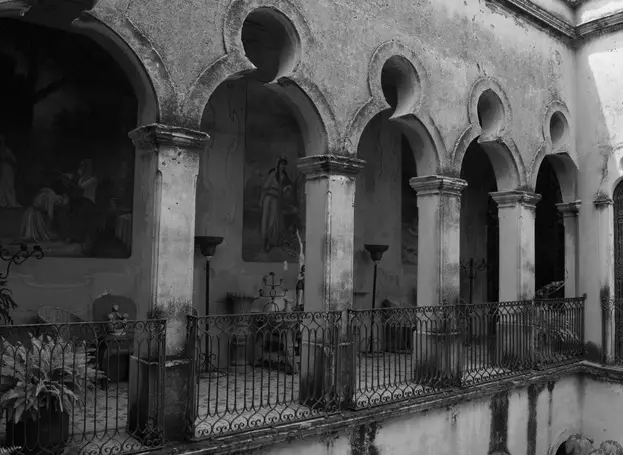 In the 1890s the cousin of Mexico’s president Porfirio Díaz, a man named Segundo Díaz, built an opulent residence on Calle de San Felipe in the heart of the city. Construction on this palatial home ended in 1910, the year the Mexican Revolution began. The house had 24 rooms, two dining rooms, a chapel, 4 patios and ten bathrooms. It also sat on a big chunk of land. Part of the property was sold to Segundo Díaz’ brother, Miguel, who converted the land into a diary. Cows could roam freely throughout the patios and gardens, so the site got the nickname “Palacio de las Vacas,” or “Cow Palace.” The Díaz family eventually sold the properties and the Cow Palace was used as a school for girls, an elementary school, a high school, a theater, and upholstery place and possibly even a brothel. The magnificent building fell into disrepair and in the 1970s a private owner tried to destroy the building but left the job unfinished. Passersby and neighbors would say that the dilapidated old building could not be destroyed because of the many spirits who took up residence in the abandoned palace. The property was sold twice, to two Americans who had grand plans for the once-grand home, and for a short time a small café existed there known throughout town for is heavenly cheesecake. The café conducted tours of the upper floors of the Cow Palace which had not been restored and was still in very poor condition. Many people taking the tours claimed to have seen shadow people or heard screams. Those who had such encounters said they were of young children. Some theorized that the ghosts go back to the time with the palace served as a school while others believe that the screams and ghostly images are from children who had played among the dangerous ruins over the years and had died accidental deaths. The Cow Palace is currently boarded up again and any phantoms residing there are living in relative peace.
In the 1890s the cousin of Mexico’s president Porfirio Díaz, a man named Segundo Díaz, built an opulent residence on Calle de San Felipe in the heart of the city. Construction on this palatial home ended in 1910, the year the Mexican Revolution began. The house had 24 rooms, two dining rooms, a chapel, 4 patios and ten bathrooms. It also sat on a big chunk of land. Part of the property was sold to Segundo Díaz’ brother, Miguel, who converted the land into a diary. Cows could roam freely throughout the patios and gardens, so the site got the nickname “Palacio de las Vacas,” or “Cow Palace.” The Díaz family eventually sold the properties and the Cow Palace was used as a school for girls, an elementary school, a high school, a theater, and upholstery place and possibly even a brothel. The magnificent building fell into disrepair and in the 1970s a private owner tried to destroy the building but left the job unfinished. Passersby and neighbors would say that the dilapidated old building could not be destroyed because of the many spirits who took up residence in the abandoned palace. The property was sold twice, to two Americans who had grand plans for the once-grand home, and for a short time a small café existed there known throughout town for is heavenly cheesecake. The café conducted tours of the upper floors of the Cow Palace which had not been restored and was still in very poor condition. Many people taking the tours claimed to have seen shadow people or heard screams. Those who had such encounters said they were of young children. Some theorized that the ghosts go back to the time with the palace served as a school while others believe that the screams and ghostly images are from children who had played among the dangerous ruins over the years and had died accidental deaths. The Cow Palace is currently boarded up again and any phantoms residing there are living in relative peace.
- The House of the Dogs
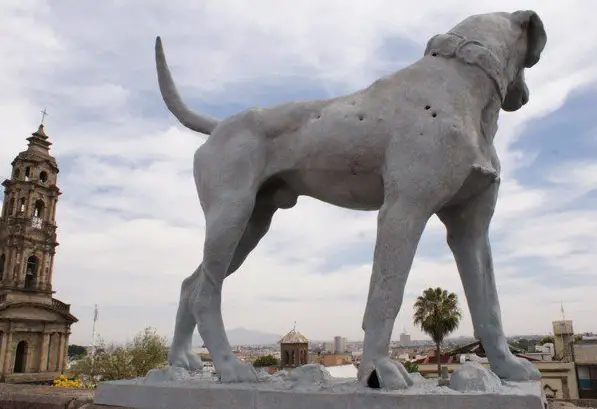 There are a few legends connected to this old mansion which was once the location of Guadalajara’s first printing press in 1792. Long after the presses moved, the opulent building in the old colonial part of the city had been converted to a private residence. In the early part of the 20th Century a wealthy coffee merchant bought the home and lived there for many years in solitude. The man’s name was Jesús Antonio Flores. At the age of 70 he finally married. His young bride’s name was Ana González, and she set about to redecorating the home which had an eerie, closed-off feeling to it. Once on a trip to Europe, the ship they were on encountered a terrible storm and the hull was almost torn apart. While the ship was sinking, the husband and wife thought they would not make it and made a pact with each other: Both swore that if one survived, the other would pray the rosary on the anniversary of the death of the one who passed away. Fortunately, they both survived and returned to Mexico. Ana continued to refurbish their mansion and ordered two dog sculptures from New York to be put on the roof of the house to act as symbolic guardians. This is how the house eventually got its name: La Casa de los Perros. A few years later, Don Jesús passed away and Ana remarried, forgetting to say the rosary on his death anniversary as they had promised on the sinking ship. Consequently, much bad luck befell Ana and she eventually lost the house. It is said that anyone who goes to Jesús Flores’ mausoleum at the Mezquitlán Cemetery and prays a rosary novena at midnight on the anniversary of the man’s death holding but one candle has a chance to get title to the famous House of the Dogs. Many people have tried this, but no one has ever gotten magical ownership over the home. Since the death of Don Jesús many paranormal things have been reported at this man’s former residence. Neighbors allege that sometimes on the anniversary of his death, the left dog sculpture on the roof just disappears. Also, many have reported a wailing ghost of an old man walking in and around the building, which now belongs to the City of Guadalajara and serves as the Museum of Journalism and the Graphic Arts. People working at the museum have witnessed objects moving on their own and have reported strange sounds. Perhaps it is the ghost of Don Jesús wondering why his wife did not honor their promise on the sinking ship oh so long ago.
There are a few legends connected to this old mansion which was once the location of Guadalajara’s first printing press in 1792. Long after the presses moved, the opulent building in the old colonial part of the city had been converted to a private residence. In the early part of the 20th Century a wealthy coffee merchant bought the home and lived there for many years in solitude. The man’s name was Jesús Antonio Flores. At the age of 70 he finally married. His young bride’s name was Ana González, and she set about to redecorating the home which had an eerie, closed-off feeling to it. Once on a trip to Europe, the ship they were on encountered a terrible storm and the hull was almost torn apart. While the ship was sinking, the husband and wife thought they would not make it and made a pact with each other: Both swore that if one survived, the other would pray the rosary on the anniversary of the death of the one who passed away. Fortunately, they both survived and returned to Mexico. Ana continued to refurbish their mansion and ordered two dog sculptures from New York to be put on the roof of the house to act as symbolic guardians. This is how the house eventually got its name: La Casa de los Perros. A few years later, Don Jesús passed away and Ana remarried, forgetting to say the rosary on his death anniversary as they had promised on the sinking ship. Consequently, much bad luck befell Ana and she eventually lost the house. It is said that anyone who goes to Jesús Flores’ mausoleum at the Mezquitlán Cemetery and prays a rosary novena at midnight on the anniversary of the man’s death holding but one candle has a chance to get title to the famous House of the Dogs. Many people have tried this, but no one has ever gotten magical ownership over the home. Since the death of Don Jesús many paranormal things have been reported at this man’s former residence. Neighbors allege that sometimes on the anniversary of his death, the left dog sculpture on the roof just disappears. Also, many have reported a wailing ghost of an old man walking in and around the building, which now belongs to the City of Guadalajara and serves as the Museum of Journalism and the Graphic Arts. People working at the museum have witnessed objects moving on their own and have reported strange sounds. Perhaps it is the ghost of Don Jesús wondering why his wife did not honor their promise on the sinking ship oh so long ago.
- The Hospicio Cabañas
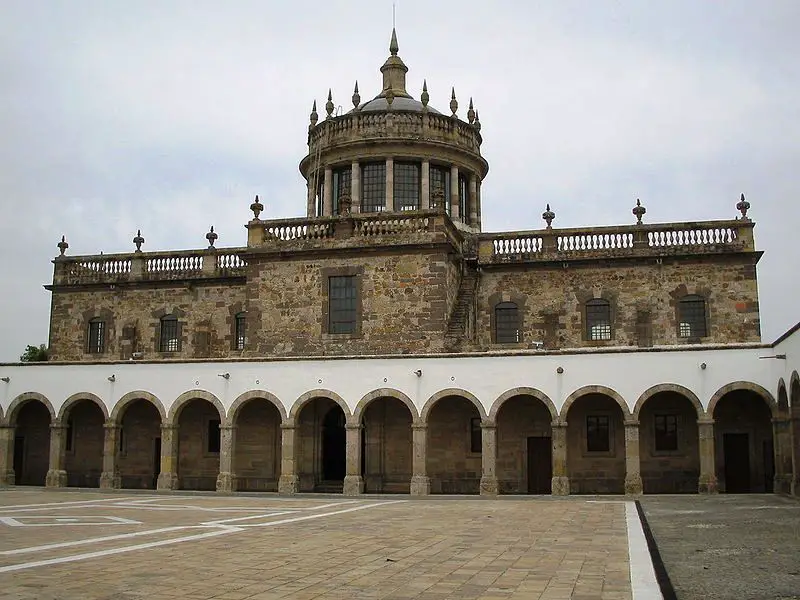 One of the oldest and largest hospital complexes in the Americas exists in the colonial heart of Guadalajara just east of the city’s metropolitan cathedral. Built between 1791 and 1829, for most of its time the neoclassical complex served as a hospital, poorhouse and orphanage. It ceased serving those uses in 1980 and became a UNESCO World Heritage Site in 1997. Today the magnificent Hospicio houses the Cabañas Cultural Institute and visitors can enjoy a museum and the arts and crafts schools found on the grounds. Because of its longstanding use as a house for the poor, as an orphanage and as a hospital, there are many legends and accounts of paranormal activity surrounding the great building. According to many historians the Hospicio was the site of Guadalajara’s first clock. This clock would always stop for no reason, and people began claiming that when the clock did stop a child in the orphanage or hospital would die. That led to rumors that the devil himself was lurking around the Hospicio tormenting sick and orphaned children and eventually killing them, attempting to steal their souls. The people who worked at the Hospicio were so frightened by what was going on that the clock was eventually removed. The souls of the children who passed away when the clock stopped, however, are still in a state of limbo and their spirits are said to haunt the Hospicio grounds to this day.
One of the oldest and largest hospital complexes in the Americas exists in the colonial heart of Guadalajara just east of the city’s metropolitan cathedral. Built between 1791 and 1829, for most of its time the neoclassical complex served as a hospital, poorhouse and orphanage. It ceased serving those uses in 1980 and became a UNESCO World Heritage Site in 1997. Today the magnificent Hospicio houses the Cabañas Cultural Institute and visitors can enjoy a museum and the arts and crafts schools found on the grounds. Because of its longstanding use as a house for the poor, as an orphanage and as a hospital, there are many legends and accounts of paranormal activity surrounding the great building. According to many historians the Hospicio was the site of Guadalajara’s first clock. This clock would always stop for no reason, and people began claiming that when the clock did stop a child in the orphanage or hospital would die. That led to rumors that the devil himself was lurking around the Hospicio tormenting sick and orphaned children and eventually killing them, attempting to steal their souls. The people who worked at the Hospicio were so frightened by what was going on that the clock was eventually removed. The souls of the children who passed away when the clock stopped, however, are still in a state of limbo and their spirits are said to haunt the Hospicio grounds to this day.
- The House of the Black Clover
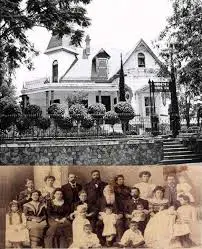 Located in the Colonia Americana neighborhood in Guadalajara, in Spanish it’s called La Casa del Trébol Negro. This luxurious home was built by a minor member of the British nobility, a man named Lord Duncan Cameron. In each room Lord Duncan had painted a black clover as a reminder of his family history and the country he left behind. Lord Duncan’s son George married a beautiful young woman named Josefina Rivera who hailed from a wealthy family from the Mexican state of Durango. George and Josefina lived in that house and raised several children there. As the legend goes, one of their teenage daughters hanged herself in her bedroom. This was the beginning of much turmoil in the family. Josefina eventually took the children and left George who was to live out the rest of his life in the old mansion, which was slowly falling into disrepair. After George’s death, a subsequent owner bought the house with the intention of restoring it. After moving in, for some unknown reason this man soon killed himself and his wife and daughter. According to neighbors and eyewitnesses, in the early hours of the morning one can hear screams coming from the house and see shadows through the windows. A woman in white has also been seen lurking around the property at night. Witnesses have also claimed to have seen blood ooze out of the walls. People who live and work in the area know to steer clear of the House of the Black Clover.
Located in the Colonia Americana neighborhood in Guadalajara, in Spanish it’s called La Casa del Trébol Negro. This luxurious home was built by a minor member of the British nobility, a man named Lord Duncan Cameron. In each room Lord Duncan had painted a black clover as a reminder of his family history and the country he left behind. Lord Duncan’s son George married a beautiful young woman named Josefina Rivera who hailed from a wealthy family from the Mexican state of Durango. George and Josefina lived in that house and raised several children there. As the legend goes, one of their teenage daughters hanged herself in her bedroom. This was the beginning of much turmoil in the family. Josefina eventually took the children and left George who was to live out the rest of his life in the old mansion, which was slowly falling into disrepair. After George’s death, a subsequent owner bought the house with the intention of restoring it. After moving in, for some unknown reason this man soon killed himself and his wife and daughter. According to neighbors and eyewitnesses, in the early hours of the morning one can hear screams coming from the house and see shadows through the windows. A woman in white has also been seen lurking around the property at night. Witnesses have also claimed to have seen blood ooze out of the walls. People who live and work in the area know to steer clear of the House of the Black Clover.
The last story is taken from Mexico Unexplained Episode 55 titled, “The Legends of the Santa Paula Cemetery.” https://mexicounexplained.com//legends-santa-paula-cemetery/ It tells the sad tale of a young boy named Nachito:
The date was May 24th 1882. A big storm was about to hit Guadalajara. A young couple was putting their son to bed, a boy who was not even 10 years old. His name was Ignacio Torres Altimirano. His parents and grandparents lovingly called the young boy “Nachito.” As Nachito was afraid of the dark, he always had to sleep with two lit torches outside his bedroom window and slept with the windows open. On this night in May when the storm hit Guadalajara, the torches blew out. In the morning of the next day, Nachito’s mother entered his room and could immediately tell something was very wrong as the room was extremely cold. She ran to her son’s bed to find Nachito motionless and as cold as the room. It was later determined that Nachito had 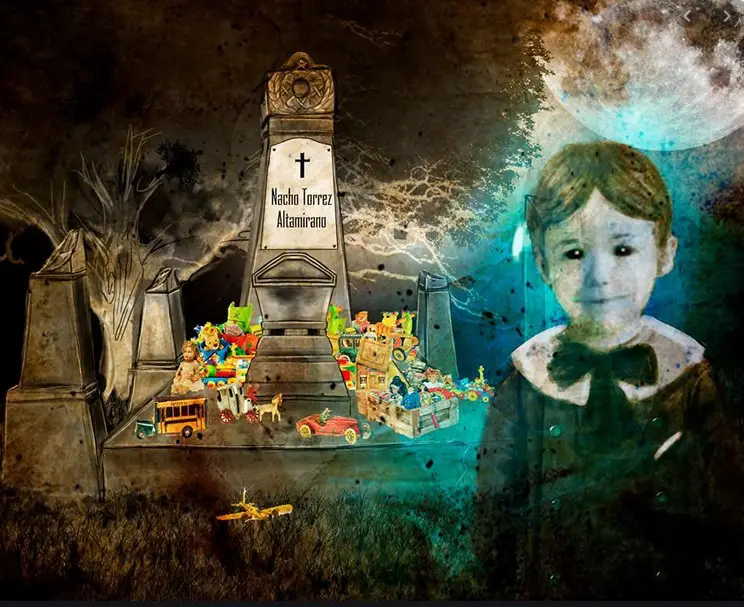 died of a heart attack that night because of his intense, almost pathological, fear of the dark. Rumors began to spread that the young boy’s heart had exploded inside his chest and Nachito’s horrible death was the result of a curse or was the work of demons. Nachito was quickly interred at the nearby cemetery – called by locals, El Panteón de Belén – and the strangeness that began with his death did not end quickly. The next morning, the boy’s coffin was found dug out of the ground and lying peacefully next to the hole that was Nachito’s grave. The parents and the locals alike were alarmed, and the cemetery caretaker reburied the boy’s coffin. The next morning, the same thing happened, and it happened again for 9 consecutive days. Nachito’s parents concluded that because the boy was so afraid of the dark, he did not want to be kept buried in the ground away from the light. The solution was to create a stone coffin to stand on 4 short pillars above ground, so Nachito’s tomb could always see sunlight. Since the time of Nachito’s death many people visiting the cemetery have claimed to have either seen or heard a young boy matching Nachito’s description, or have seen mysterious balloons floating evenly about 3 to 4 feet over the cemetery as if being carried by a small child. Strangely, Nachito’s tomb draws the curious from all parts of Mexico, some of whom leave him a toy and ask him for a favor. On Children’s Day – April 30th – and Christmas Day especially, the area surrounding Nachito’s final resting place can become covered in small toys and plush animals. The caretakers of the cemetery always donate the offerings to local hospitals and the items end up in the hands of terminally ill children. From beyond the grave little Nachito continues to have an impact on the living world from his permanent home in this cemetery.
died of a heart attack that night because of his intense, almost pathological, fear of the dark. Rumors began to spread that the young boy’s heart had exploded inside his chest and Nachito’s horrible death was the result of a curse or was the work of demons. Nachito was quickly interred at the nearby cemetery – called by locals, El Panteón de Belén – and the strangeness that began with his death did not end quickly. The next morning, the boy’s coffin was found dug out of the ground and lying peacefully next to the hole that was Nachito’s grave. The parents and the locals alike were alarmed, and the cemetery caretaker reburied the boy’s coffin. The next morning, the same thing happened, and it happened again for 9 consecutive days. Nachito’s parents concluded that because the boy was so afraid of the dark, he did not want to be kept buried in the ground away from the light. The solution was to create a stone coffin to stand on 4 short pillars above ground, so Nachito’s tomb could always see sunlight. Since the time of Nachito’s death many people visiting the cemetery have claimed to have either seen or heard a young boy matching Nachito’s description, or have seen mysterious balloons floating evenly about 3 to 4 feet over the cemetery as if being carried by a small child. Strangely, Nachito’s tomb draws the curious from all parts of Mexico, some of whom leave him a toy and ask him for a favor. On Children’s Day – April 30th – and Christmas Day especially, the area surrounding Nachito’s final resting place can become covered in small toys and plush animals. The caretakers of the cemetery always donate the offerings to local hospitals and the items end up in the hands of terminally ill children. From beyond the grave little Nachito continues to have an impact on the living world from his permanent home in this cemetery.
REFERENCES (all in Spanish)
canaldemisterio.com
zonaguadalajara.com
matadornetwork.com

2 thoughts on “Ghostly Guadalajara”
I’ll be traveling to Guadalajara in June. Are there any ghost tours that you would suggest contacting?
There are many out there, one as good as the other, I suppose. I would check with the front desk clerk at your hotel.